https://www.youtube.com/watch?v=i-uRgmK5Tx0
How to Lay Artificial Lawn _ Mitre 10 Easy As DIY
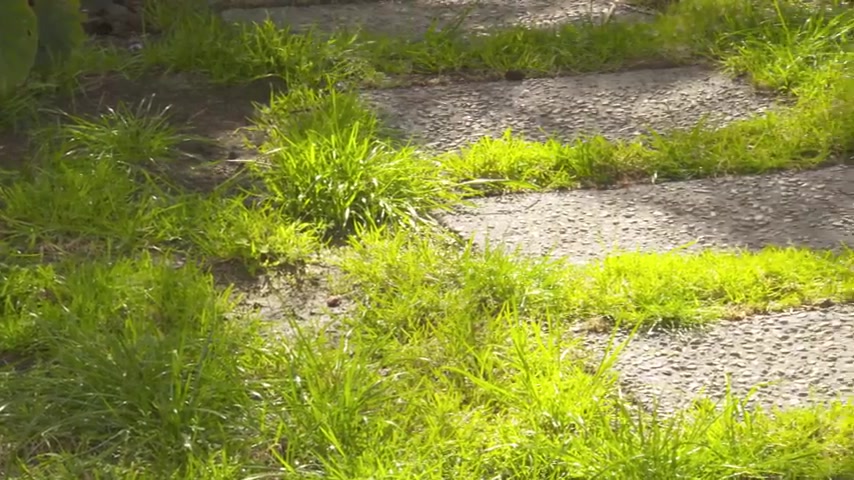
If you've got an area of grass that just won't grow due to shade trees or a trampoline or even a small patch of lawn that's hardly worth getting the lawnmower out for then installing some artificial lawn could be just the thing for you .
It's low maintenance and actually looks great .
In fact , these days , you can hardly tell it's not real .
I'll show you how to get the job done easy .
As now , just before we crack into it , you might want to check with your local council because there are a few regulations that you may need to comply with .
Now , we want to remove about 60 to 80 millimeters of our organic matter here .
Basically , we want to get down to something firm , dig out all the areas of your lawn that you're going to cover .
Ok .
I'm just about down at my correct depth .
Got a little bit more to take out .
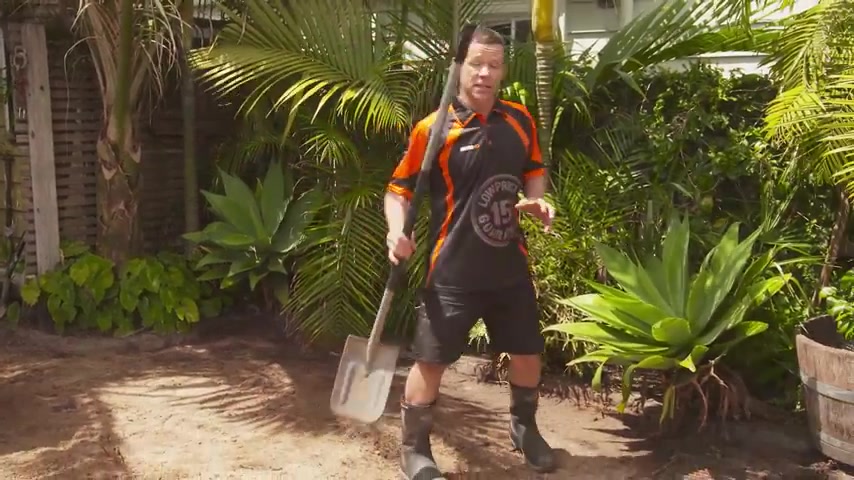
Now , pretty lucky here , we've actually struck sand .
Now , this has been compacted really nice and tight .
So the good thing about having a sand as a substrate is , is really free draining .
Now , if you've got a lawn that tends to flood or is a little bit boggy .
You might want to think about putting in a drain coil .
Now , the people of this house have already installed a drain coil with a filter sock leading up to our cesspit .
Now , as you can see in the cesspit , we've got a drain coil coming across the lawn with a filter sock around it into our cesspit .
Now , you can do all this work with the drain coil side of things with a filter sock on it and your cesspit yourself .
However , from the cesspit to your stormwater , you're gonna need to get a drain layer involved when you finish digging out , rake your lawn as even and level as you can .
Now , in order for our lawn to have a nice clean edge to finish up against , we'd need to have a garden border .
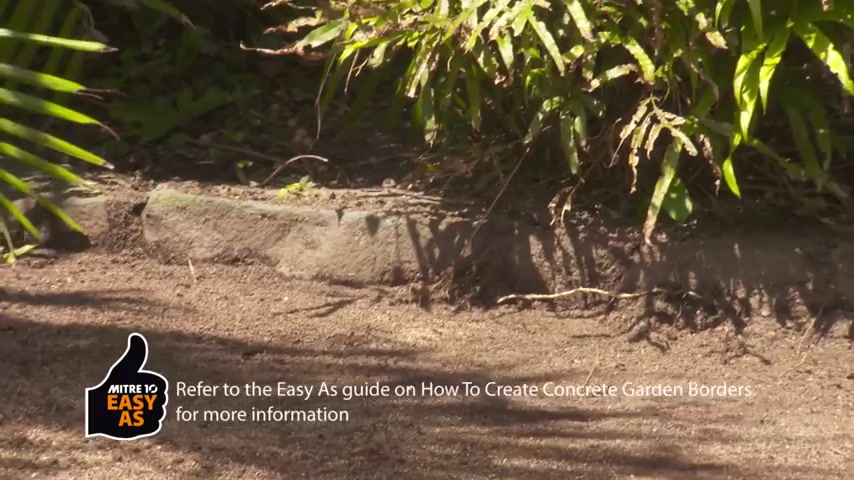
Now , we're pretty lucky in this situation .
There's already one installed , but if you want to learn how to do it , check out a couple of our garden border videos online .
I've dug down 80 millimeters .
Now , I'm gonna finish my lawn about 10 to 15 millimeters down from the top of our pavers and our decking .
Now , I've got our gap 20 placed in here .
I'm gonna spread that out .
So it's about 50 millimeters thick .
I'm then gonna put a compactor on it and that'll take it down to about 40 millimeters .
Next , I'm gonna spread out my gap seven .
Now , I want about 30 millimeters of that and I'm gonna level that out and compact it .
So I'm gonna finish off with a beautiful , nice level lawn .
Now , here's a great little tip for you .
I've got some PV C pipe and I've got a 30 mil PV C pipe .
I've just laid that straight on top of my base course .
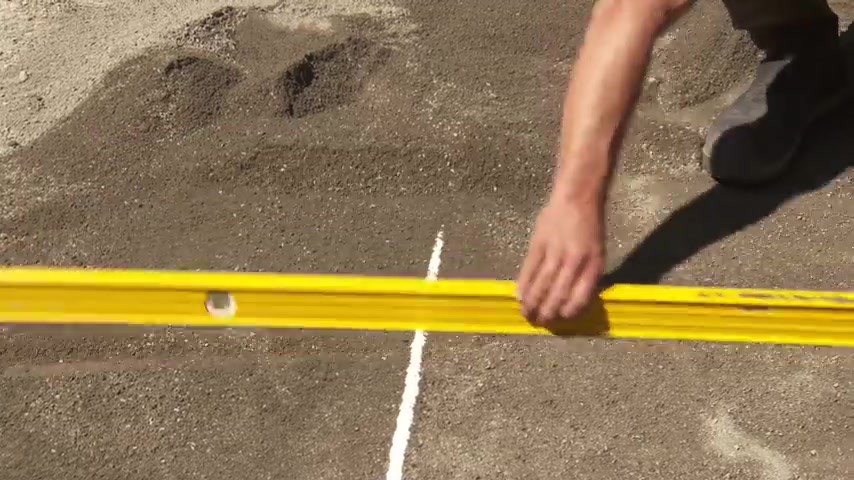
And I'm gonna use a level to screed across so you can use a flat bit of timber if you like .
And then we're just gonna sit that on top of our PV C pipe and screed our finds out that way .
I'm sure to get a perfectly flat finish next , carefully , lift out the pipe , then fill the gaps and level off the top with the screed and once again compact the stem .
Ok .
Just to finish up , I'm just taking off any little loose bits that are left on the top and then we'll just sweep those away and then we're ready to start measuring up for our lawn .
The artificial lawn has come a long way .
We started off with our seven millimeter artificial lawn right up to our 35 millimeter and then about a 20 millimeter lawn .
So the great thing about this is perforated .
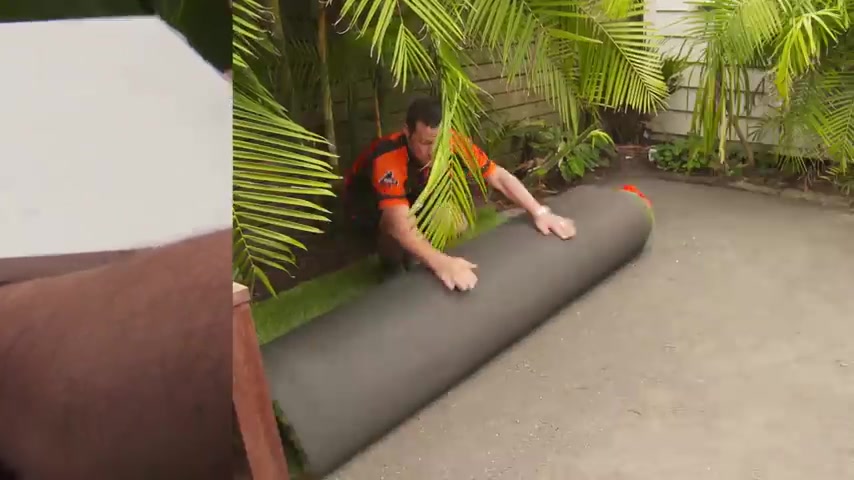
So there are holes in it that is so the water can drain all the way through .
And the good thing about these two options here , it's lots of different blends in there .
So it looks exactly like real lawn .
Now , with this one here it's really nice and lush and thick .
So , today that's the one we're gonna lay .
The .
Next thing I'm gonna do is measure the lawn and make a plan of the area .
This should give me the total size of my lawn .
So I know exactly how much artificial lawn to buy .
Now , there's a couple of different ways I could roll this out either from left to right or front to back .
The reason I've gone from left to right is because when I'm standing inside the house and looking out , we're less likely to see any joints .
Now , I've got a factory edge on the edge of my roll .
So I've buttered that hu up against our deck .
So we don't need to overhang that .
But my garden edging its stone water .
So they are a little bit in and out .
So I'm just gonna overhang that and we'll chop that off later .
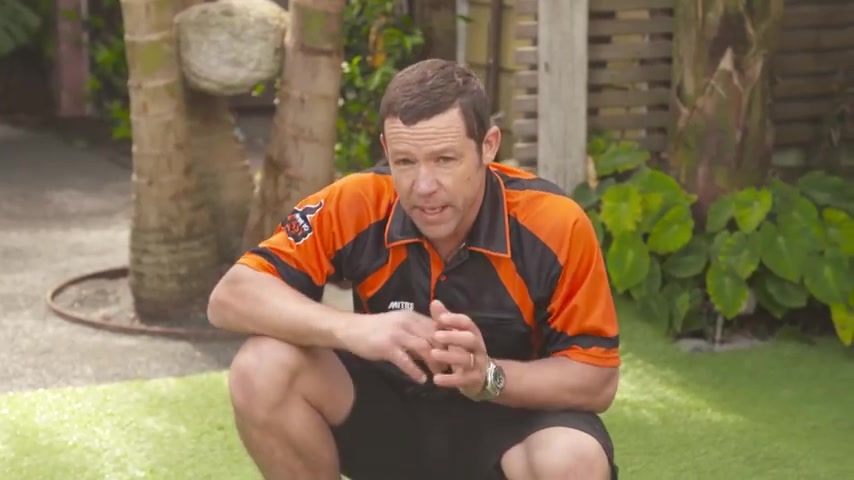
So I'm gonna continue to roll this all the way out and then we'll come back and chop out for these pavers a little bit later .
Now , there's quite an important little tip .
I need to tell you before we get on to the taping of the seams .
So underneath the mat , we've got all the stitching that's about half an inch apart or about 12 , 13 millimeters .
So what we want to do is replicate that .
So in between each one of those is about 12 millimeters on the edge of my mat my cut line is hard up against our stitching on this side .
Here .
I want to make sure it's round about the same sort of distance away , around about 10 to 13 millimeters , something like that .
So when these go together , we're going to get exactly the same even finish .
We don't want two big pieces of mat butting up .
Otherwise you may see a black line .
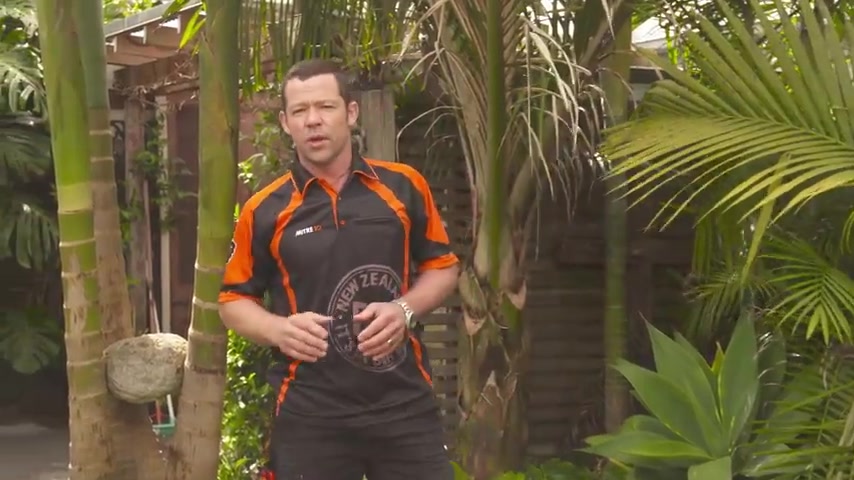
Now when you are rolling out your lawn , you just want to make sure that you start all the rolls all from the same direction go out because believe it or not , there is actually a grain to this and we want to make sure that that matches , ok .
The next thing we're gonna do is tape the seams together .
So to do that , I've opened this up and I've just put a light scratch line in between where that joint was .
Now , I've precut my length of my tape and we're just gonna roll that out right in the middle on that line .
Now , just before we peel off the back of the tape , we just want to make sure that the back of our turf is actually nice and clean .
We've given that a dust down .
So what we're gonna do is just make sure we get the two seams of the turf fitting nice and snug together and we want to make sure that none of the strands are actually going into the tape , everything is sticking out .
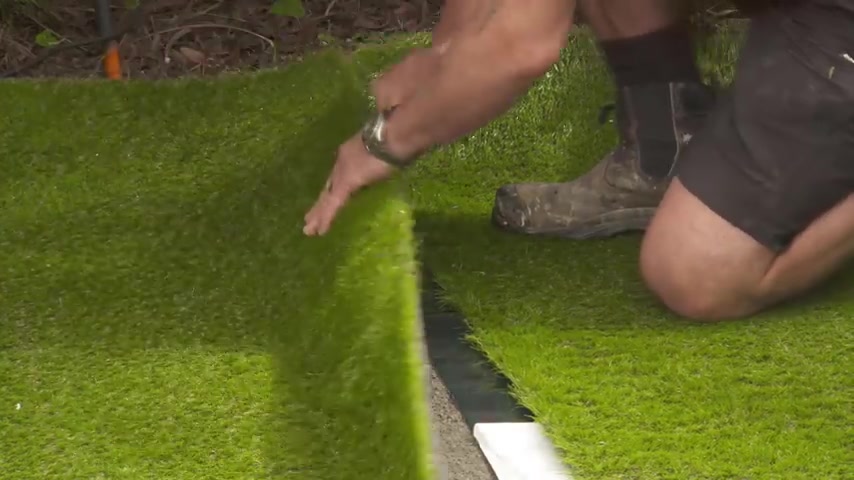
Yes .
Yes .
Right here .
It's now time to pin our lawn down .
There's a couple of different ways I can go about this .
I can either use a 1 50 mil or a six inch galvanized nail with a flat head on it or I can use a weed mat staple .
Now , if you do decide to use your weed mat staple , there are a couple of little tips when doing that .
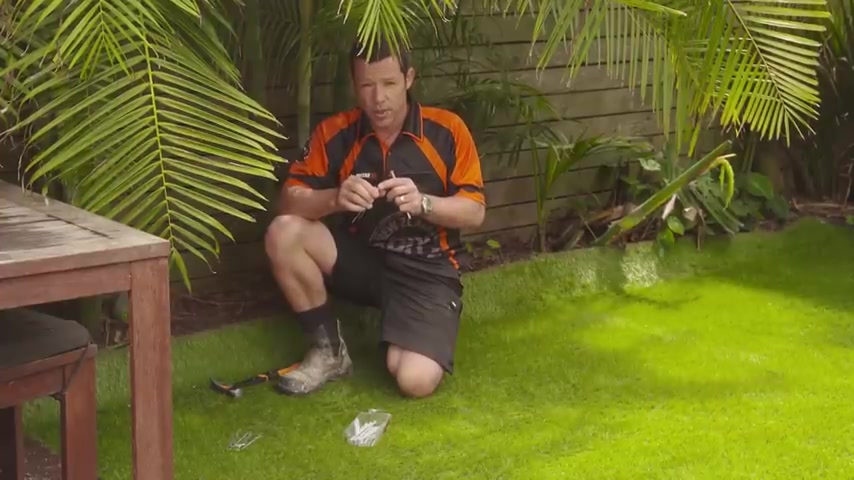
You just want to make sure when you're puncturing it through your mat that you don't actually trap any of the grass underneath it .
So otherwise you will see the top of it .
So what we're gonna do , I'm gonna use the six inch gal nail and I'm just gonna come in about 60 millimeters in from the edge of my border and then I'm gonna put them about every 200 millimeters .
So , what I'm gonna look for is a nice clear bit of the under mat .
OK ?
Yes .
Now , if you're in a situation where you feel that you need to stretch your mat out to get a few wrinkles out of it , you can actually put your nail in on quite an angle and then pull it over and that's gonna stretch it for you .
But I've got this laid really nice and tight .
So basically , I'm just gonna put it straight down now , just make sure that that head does not get any of the grass trapped underneath it and that just disappears like that .
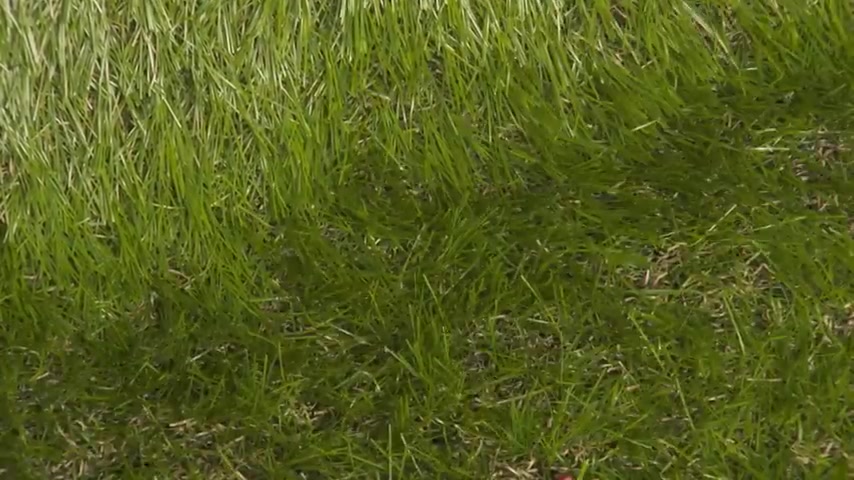
I've also put a nail down in the middle of every square meter of lawn .
Ok .
Now that I've pinned it down , I'm just trimming the outside edges in this particular situation where our bricks are a little bit in and out .
So , gotta be quite careful and a good way to do that is by using one of these extendable snap off blades , make sure it's really , really sharp .
You probably go through a few of them because you do cut through stones and you are up against your block work .
You might want to change these probably every 10 minutes or so .
So basically , you just want to get it nice and tight , trim it off .
And if you feel like it's bubbling up a little bit , you can just pin it down with your six inch nail or your staple .
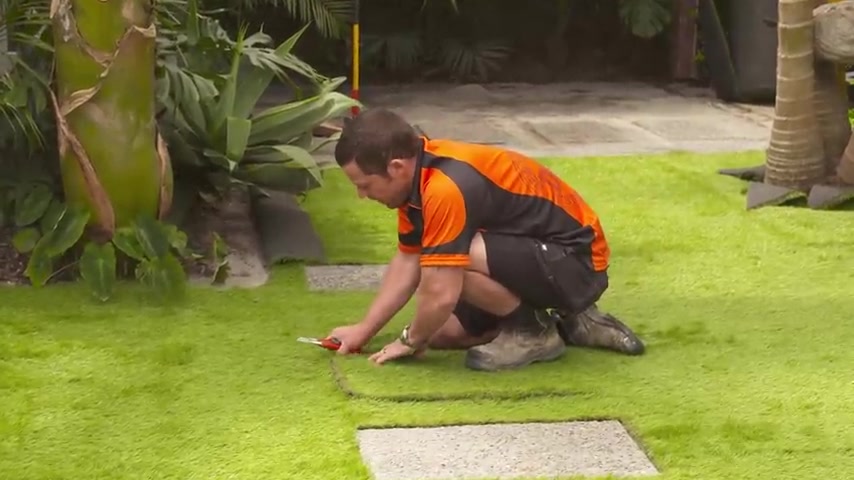
If you do have a paver that you need to cut around , basically , all I'm doing here is I'm finding the edge of my paver and then I'm just gonna drop my knife and hard up against it and I'm gonna use the edge of the paper like a straight edge and I'm just gonna follow the , the line of that paper with a really nice sharp blade and just gotta follow that line along .
You just want to take your time , obviously , because you don't wanna overshoot your mark , just make sure that you're not going past your paver .
If you feel like you don't , you're not that confident on doing it .
This way , you could actually cut a hole in the middle of your paver and the grass here .
So that's gonna expose it and you'll be able to see a little bit more of where the edges are .
Ok .
So now all I have to do is just pin that around .
So I'll probably pin that maybe every 100 millimeters around that because this is a high foot traffic area .
Now , if you had a tree in the middle of the lawn , you'd pretty much do exactly the same thing .

You could either put a border around the tree .
If you got a steel ring , you just use that to cut around as well .
Now , brush the lawn to lift the strands .
Ok .
There's only a couple of last steps .
We gotta do this .
One here is throwing out some sand .
Basically , I've got some really nice fine sand here and it's kiln dried .
The reason I'm using this is because it's gonna throw out a lot easier .
It's not gonna clump .
The reason why we've put sand down .
There's a couple of different reasons .
One is so it's gonna actually help weight down our turf two .
It's also going to stop any organic matter from blocking up the holes .
So the water can run through .
And three also , it helps the blades of the turf stand up .
Right .
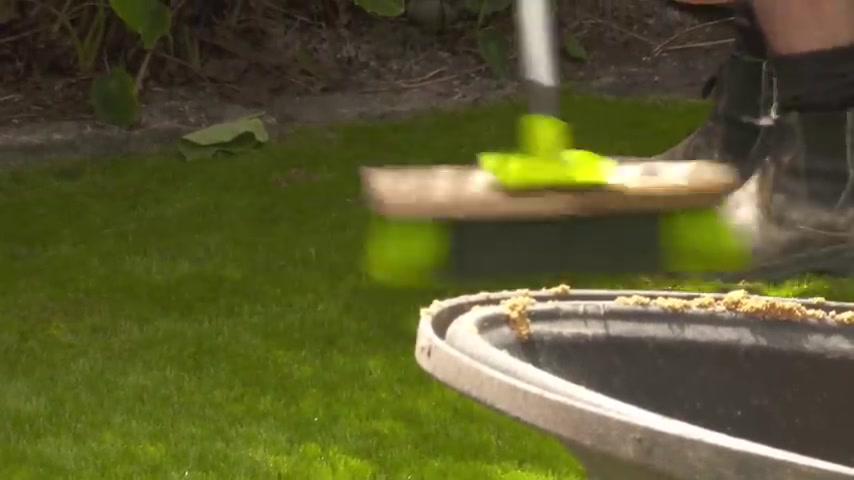
So , basically , we just want to throw this out quite lightly and then we're just gonna brush it in , check it out , you wouldn't know that that's not real grass and now you can get rid of the old lawnmower .
Are you looking for a way to reach a wider audience and get more views on your videos?
Our innovative video to text transcribing service can help you do just that.
We provide accurate transcriptions of your videos along with visual content that will help you attract new viewers and keep them engaged. Plus, our data analytics and ad campaign tools can help you monetize your content and maximize your revenue.
Let's partner up and take your video content to the next level!
Contact us today to learn more.